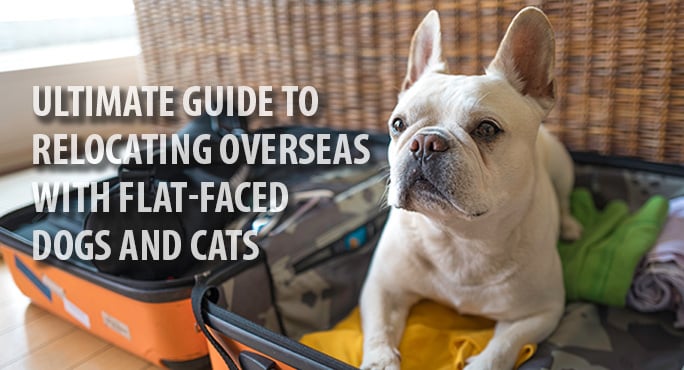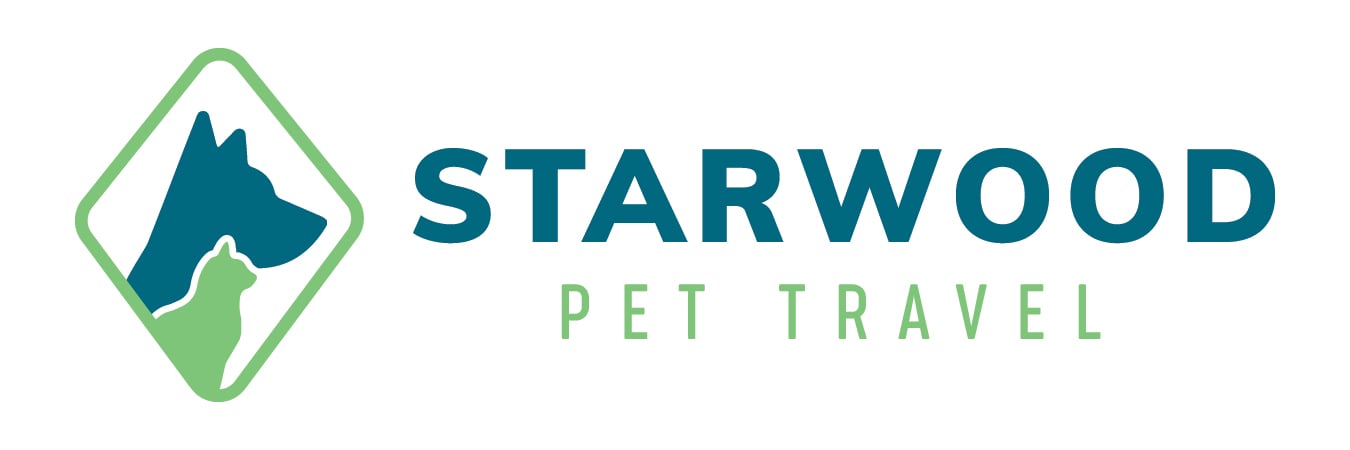Ultimate Guide to Relocating Overseas with Flat-Faced Dogs and Cats
Published on: November 29, 2019 | Author: Starwood Pet Travel

Introduction
Any overseas relocation that includes family pets will be challenging. Pet travel adds considerably to your to-do list because it can be convoluted, confusing, and time-consuming. On top of that, every pet parent is naturally concerned about how your furry beloved will weather the journey. Could it get any more complicated?
Well, yes, if your Princess is a flat-faced dog or cat.
As air travel for pets has become commonplace, airlines, pet transport companies, and pet owners have come to understand that flying poses greater risks for snub-nosed cats and dogs compared to those with normal, longer snouts. To protect themselves – and each animal -- airlines have instituted new rules that govern how and when flat-faced pets can travel.
In this guide, we explain the challenges of relocating a flat-faced pet overseas and what you’ll need to do to assure your precious Princess has a safe and smooth travel experience.
What is Brachycephaly?
A bulldog’s toothy underbite, a pug’s big eyes, a Shar-Pei’s wrinkly face and a Persian cat’s snoring all have something in common. They are signs of brachycephaly -- the medical term for dogs and cats with abnormally short snouts. Among the many breeds that fall into this category, some have only partially reduced muzzles, whereas others have truly flat faces.
All brachycephalic dogs and cats suffer to some degree from a range of problems directly or indirectly caused by their shortened snout. However, pets that are mixed breed may not show any physical traits or functional symptoms.
The biggest issue is breathing difficulty. All dogs or cats have the same nasal anatomy. But in your Princess, everything is smushed into much shorter space, deforming her nostrils, mouth, throat and perhaps even her windpipe. Air cannot flow well through these convoluted structures, which is why Princess has so much trouble breathing. It also explains why she snorts and snores, and why she tires so easily when exercising.
Because Princess cannot breathe properly, she doesn’t get enough oxygen. That can lead to secondary health problems. Her teeth are crooked because there isn’t enough room for them. That can lead to dental problems, difficulty eating, and gastrointestinal issues. Her big, bulging eyes are extra-prone to dry eye and other ocular problems. And if she has that signature wrinkly skin, she is also more vulnerable to skin infections due to poor air circulation.
Princess may not exhibit all these symptoms, and in her case they may not severely affect her everyday life. But the fact that she is a flat-faced breed puts her at higher risk for air travel. That doesn’t necessarily mean she can’t relocate with you, but it does mean you will need to be extra-vigilant in planning her journey.
How Airlines Handle Flat-Faced Pets
Two things affect whether Princess will be able to relocate with you. Her own fitness to fly and airline pet travel policies.
Airlines that accept pets have beefed up their own vigilance in recent months because flying and the activities surrounding air travel can significantly increase risks for brachycephalic dogs and cats. Any pet can feel stressed, faced with a cacophony of strange sounds, sights, smells and movement. In flat-faced pets, increased anxiety exacerbates breathing difficulties.
It is important to note that every airline addresses this issue in its own way. Some have made a simple, across-the-board decision not to transport any brachycephalic pets. Most, however, have created special guidelines and restrictions that apply to flat-faced pets. Be aware, though, that different airlines use different lists of “brachycephalic” dog and cat breeds.
The upshot is that Princess may be embargoed by one airline but welcomed by another. The only way to know is to research each airline’s policies and check on their website to find the list of breeds they consider brachycephalic. If Princess is a cross-breed, specifically check to see if your airline considers her “brachycephalic” or only limits their guidelines to purebreds.
Airline policies for snub-nosed pets typically relate to:
- Weather extremes are risky for all pets, so all airlines restrict pet travel when it’s very cold or very warm. Since heat is especially hard on snub-nosed dogs and cats, many airlines have stricter limitations for them during summer. Some airlines won’t take pets between May and September, depending on the locations involved. This applies to domestic as well as international cities.
- Pet size. Cats and very small dogs can often ride in the passenger cabin, whereas larger dogs must ride as checked baggage or cargo. If you’re relocating overseas, only a few foreign countries allow incoming pets to arrive as in-cabin passengers. On the other hand, some airlines don’t allow flat-faced pets in the hold. Finding an airline that serves your departure and destination cities and that will accept Princess could be difficult.
- Flight duration. The longer the flight, the tougher it is on any pet. Some airlines restrict how long flat-faced pets can be in the air.
Problematic Travel Conditions
Air travel is not on any pet’s wish list. But being with you is their #1 priority, so if your family is relocating overseas, Princess will be all-in. Or, at least, she will endure whatever it takes to make the move with you. There are a number of conditions that make flying potentially problematic for any pet, flat-faced or not. Many of these stressors are more acute for those with short snouts or pets with special needs.
Pet-Related Conditions
In addition to routine difficulty breathing, Princess may have one or several other health problems due directly or indirectly to her abnormal facial structure. Any or all of these issues could make lengthy confinement in a pet travel carrier harder on her body.
- How old is Princess? Elderly pets typically do not handle change as well as young dogs and cats, physically or psychologically. Older pets often suffer from arthritis, too, which can make a long stint in a pet travel crate painfully uncomfortable.
- Is she overweight? A surprising number of American pets are so chubby they are technically obese. Even an extra pound or two can endanger a small dog or cat, because excess weight puts more strain on internal systems. Flat-faced dogs and cats often suffer from eating and digestive problems such as acid reflux that could be a problem in-flight.
- Does she have a chronic illness not related to her brachycephaly? Lots of cats and dogs develop diabetes or diseases of the heart, liver, or kidneys. So you’ll want to consider your pet’s overall health when determining her fitness to fly.
Environmental or Travel-Specific Conditions
There is more to air travel than riding on a plane. All the other aspects of flying contribute to potential pet stress.
- Whether Princess rides in-cabin or in the hold, the air she breathes will be pressurized and temperature-controlled. Nonetheless, the atmosphere can seem stuffy, especially over time. It’s best for flat-faced pets traveling in cargo to use a carrier that is a size or two larger than required, but stuffiness could still be a problem for her.
- Heat and humidity. We noted above that airlines take precautions against seasonal weather extremes for all pets. Any dog or cat who exercises too strenuously when it’s hot and/or humid can become overheated and, ultimately, die from heatstroke. Normal dogs pant to cool down, but effective panting is nearly impossible for snub-nosed dogs.
Cats don’t usually pant because they don’t like to breathe through their mouth. However, like dogs, they innately know to rest calmly when they feel overheated.
- Noise and chaos. Humans mostly consider airport crowds, busy activity and noise to be simply part of the travel experience. All these things can be overwhelming for dogs and cats. It’s all very strange. No wonder they feel unsettled and anxious.
Paperwork Required for Air Travel
Every dog or cat that travels overseas needs the pet version of a passport – documents that verify the animal’s identity and overall health. This doesn’t change for flat-faced pets. Exactly what paperwork Princess will need depends on where you’re going because each country has its own policies and requirements for importing pets.
Typical paperwork may include:
- Health certificate. Every country requires this. A few have a specific form you must use, but for most international destinations, US residents will use USDA’s Form 7001. Your veterinarian will complete and sign this form. Some countries also require the form to be officially endorsed by the USDA’s designated vet.
- Princess must have a microchip, and it must be implanted before any of her paperwork is completed because every document must show her unique ID number. Most countries require microchips to be ISO compliant.
- Import permit. Not all countries require this.
Medical Requirements for Air Travel
So what does it take to get that health certificate Princess will need? We’re glad you asked, because this is one of the most time-consuming (and often convoluted) aspects of arranging any pet’s overseas relocation. Some countries have only a few medical requirements – valid rabies vaccination, for example. Most, however, have a longer list of requirements.
First, confirm with your vet that Princess is a good candidate for air travel. As noted earlier, her age, weight, and any chronic medical conditions such as diabetes can exacerbate her underlying brachycephaly. In addition to her breathing problems, does she suffer from intestinal, dental or eye problems associated with being flat-faced? Does she have organ failure – heart or liver disease, for instance – or neurological problems?
There are times when flying with a flat-faced dog or cat may be too dangerous. In this case, Princess will not be able to relocate with you. However, with the vet’s thumbs-up, you can move forward preparing for her move. You’ll need the list of your country’s specific medical requirements – some or all of these:
- Rabies vaccination, for certain. Look for minimum age and timing restrictions your destination specifies for this. Some countries do not accept multi-year vaccines. In addition to proof of current vaccination, some countries require a blood titer test to confirm that the vaccine is working effectively in your pet’s bloodstream. This test takes six months of lab time.
- Other vaccinations. Foreign countries often contend with different diseases than where you live now. So Princess may need boosters for current immunizations or new types of immunizations.
- Pest control. Virtually all countries require pets to be on a regular regimen of flea and tick control prior to import. Many also require prior testing and/or treatment for a potentially wide range of pests and parasites.
- Quarantine. Some countries (especially island nations such as Australia) will require Princess to spend some time in quarantine upon arrival, despite the fact that she has all the proper health documentation. This is an added precaution that further ensures no pet entering the country will bring pests or disease with them. (As a side note, if quarantine will be on the menu, our Starwood team can send Princess on ahead of you, so that she’ll be ready for release when you arrive.)
It is critical to know what you need to do to obtain your pet’s health documents and other paperwork. You must follow the rules exactly – no shortcuts or missing information because improper paperwork will make Princess ineligible to travel. You cannot simply check things off your to-do-list, however, because each of these tasks must be completed within specific timeframes. It’s up to you to read the requirements carefully.
What You Can Do
The first step in determining if Princess is a good candidate for relocation is consulting with her vet. Is Princess healthy enough to withstand the rigors of air travel? This will depend to some extent on the details of her itinerary – overall distance, number of flights involved, etc.
The next step is researching the policies of any airline you’re considering to relocate Princess. Will they accept her, under conditions that align with your relocation plans (timing, departure city and destination, etc.)?
If all indications is Princess is fit to fly, you can take additional steps to assure her journey is as safe, comfortable and stress-free as possible.
- Get her carrier right away
Dogs and cats must ride in a pet travel carrier or crate that meets standards set by the International Air Transport Association (IATA). These carriers provide maximum security and ventilation for pets on the move. You must use the proper size, although our Starwood team recommends choosing one or even two sizes larger for flat-faced pets, to ensure even better air flow.
Getting the carrier as soon as possible will give Princess plenty of time to become familiar with it. As her FurMom or FurDad, this is the most important step you can take to help Princess relax as she travels. While everything around her might be strange, her carrier will feel homey and safe to her.
- Do not even consider sedation
Airlines will not accept pets that have been sedated. At Starwood Animal Transport, we don’t allow that, either. These policies are based on recommendations from the American Veterinary Medical Association.
Unfortunately, tranquilizers make things worse for anxious pets. Drugs slow your pet’s ability to think and control their movements. They lose their balance, and feeling confused can frighten them. For flat-faced pets who already have difficulty breathing, the last thing you want to do is increase anxiety.
Although Princess must remain sedative-free, there are naturally calming products that are safe to use for air travel. Ask your vet for recommendations that would be best for her.
How We Can Help
Ensuring maximum safety and comfort for flat-faced dogs and cats is a work in progress. So you can expect to see airline rules continue to evolve. The best way to maintain peace of mind in this changing environment is to rely on our pet travel professionals here at Starwood Animal Transport. We are pet lovers and pet parents, just like you.
Unlike you, though, we organize and monitor pet travel for a living, and we’ve done that successfully for decades. We understand and empathize with your concerns, but we also know how to address them positively. You’ll be able to breathe easier, and so will Princess.
Starwood Animal Transport has rebranded to Starwood Pet Travel. We are still the same great company with the best team, just now with a slightly different name.
Subscribe to the Blog
Enjoy our content? Get them sent to your inbox!
Subscribe Now!


